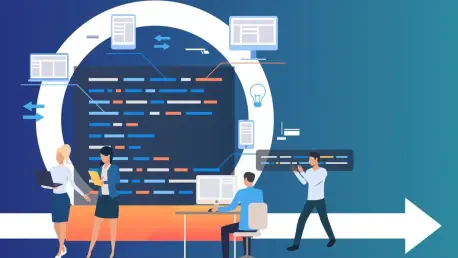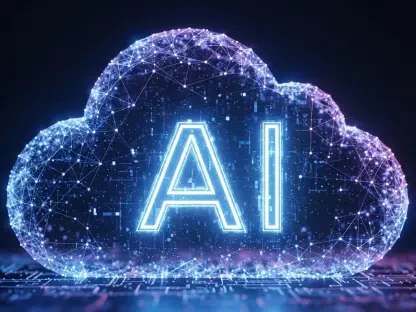Introduction to a Transformative Shift
In the fast-paced realm of software development, a staggering statistic reveals that over 60% of tech companies have integrated AI-driven tools into their workflows since the start of this year, signaling a seismic shift in how projects are executed. This rapid adoption underscores the rise of agentic engineering, a trend where AI agents autonomously tackle complex tasks like coding and testing, fundamentally altering traditional methodologies. Agile development, long celebrated for its iterative and collaborative approach, stands at a crossroads as this innovation promises to enhance efficiency while challenging established norms. This analysis delves into the essence of agentic engineering, its integration into agile frameworks, real-world applications, expert perspectives, and the potential future implications of this transformative synergy.
Understanding Agentic Engineering in Agile Contexts
Emergence and Growth of Agentic Engineering
The ascent of agentic engineering in software development is evident through compelling data from recent industry reports, showing a 35% annual increase in the adoption of AI tools by development teams since this year. Research from leading tech analysis firms indicates that a significant portion of enterprises now rely on AI agents for automating routine tasks, reflecting a global trend toward efficiency. This growth is driven by the need to accelerate delivery timelines in an increasingly competitive market, positioning agentic engineering as a cornerstone of modern development strategies.
Beyond mere numbers, the momentum of agentic engineering is fueled by its ability to handle intricate processes independently, from generating code to identifying bugs. Tech giants and startups alike are investing heavily in these tools, recognizing their potential to reduce human workload and minimize errors in repetitive tasks. As adoption rates soar, the focus shifts to how these AI agents can seamlessly fit into existing methodologies like agile, prompting a reevaluation of traditional practices.
Real-World Applications and Case Studies
Several pioneering companies have already embedded agentic engineering within their agile frameworks, demonstrating measurable improvements in productivity. For instance, a prominent software firm recently reported a 40% reduction in sprint cycles after deploying an AI platform to automate code reviews and unit testing within their Scrum teams. Such tools not only expedite processes but also allow human developers to concentrate on strategic planning and innovation.
Another compelling case study involves a mid-sized tech enterprise that integrated AI agents into their Kanban workflows to manage task prioritization and documentation. The result was a marked increase in throughput, with delivery times shrinking by nearly a third, showcasing how AI can align with agile’s emphasis on continuous delivery. These examples highlight the practical benefits of agentic engineering, illustrating its capacity to enhance rather than disrupt established agile rhythms.
A further instance comes from an open-source project where AI agents were tasked with bug tracking and resolution, directly interfacing with human developers through agile boards. This collaboration led to faster iteration cycles and improved software quality, proving that agentic tools can adapt to dynamic, user-focused environments. These real-world applications underscore the trend’s viability and its transformative impact on development speed and accuracy.
Expert Perspectives on Agentic Engineering and Agile Synergy
Insights from industry leaders reveal a nuanced view of how agentic engineering intersects with agile principles, often highlighting a complementary relationship. A senior AI researcher at a leading tech institute noted that AI agents excel in executing predefined tasks, freeing up agile teams to focus on creative problem-solving and stakeholder engagement. However, the same expert cautioned that without proper integration, AI could disrupt the collaborative spirit central to agile methodologies.
Agile coaches also weigh in, emphasizing the need to redefine team roles in light of AI’s capabilities. One veteran coach pointed out that human developers are increasingly acting as orchestrators, guiding AI agents rather than coding themselves, which requires new skills in oversight and strategy. This shift, while promising, demands training and adaptation to ensure that team dynamics remain cohesive and productive in AI-assisted setups.
Additionally, concerns about risks such as AI errors or insufficient contextual understanding are frequently raised by professionals. A software engineering director at a major firm stressed the importance of maintaining human oversight to catch potential missteps by AI agents, advocating for a balanced approach. These expert opinions collectively affirm the trend’s significance while underscoring the necessity of aligning AI autonomy with agile’s human-centric values.
Future Outlook for Agentic Engineering in Agile Development
Looking ahead, advancements in agentic AI are expected to bring about deeper contextual understanding, enabling these agents to handle more nuanced tasks within agile environments. Innovations in natural language processing and machine learning could allow AI to better interpret user stories and adapt to complex project requirements over the next few years. Such progress promises to further streamline agile workflows, potentially reducing project timelines even more significantly.
However, alongside these benefits lie challenges, particularly in maintaining quality control and managing team dynamics. As AI agents take on larger roles, ensuring the accuracy of their outputs becomes paramount, necessitating robust testing frameworks tailored to rapid development cycles. Moreover, the integration of AI could alter interpersonal interactions within teams, requiring careful attention to preserve agile’s collaborative ethos amid technological shifts.
The broader implications of this trend extend beyond software development, potentially influencing sectors like healthcare and finance where agile methodologies are gaining traction. Optimistically, agentic engineering could drive unprecedented productivity across industries by automating routine processes, yet caution is warranted against over-reliance on AI, which might lead to skill degradation or oversight gaps. This duality shapes a future where strategic adoption will be key to harnessing the full potential of this trend.
Key Takeaways and Call to Action
Reflecting on this analysis, it becomes clear that agentic engineering has reshaped agile roles, pushing teams toward strategic oversight while AI handles execution. The necessity of adapted practices, such as rigorous end-to-end testing to counter AI limitations, emerged as a critical lesson from the integration process. Furthermore, the intensified focus on metrics proved essential in managing the accelerated pace of AI-driven workflows, ensuring that performance remains measurable and risks are mitigated.
The synergy between agentic engineering and agile methodologies has demonstrated its relevance in keeping software development competitive and responsive to modern demands. As this trend continues to unfold, actionable steps include investing in training for teams to effectively guide AI agents and adopting robust validation processes to maintain quality. Staying informed about evolving tools and best practices is recommended as a vital strategy to navigate this dynamic landscape, ensuring that innovation and collaboration remain at the forefront of progress.









